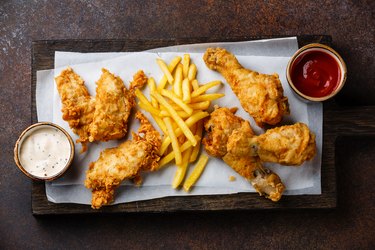Feel Like Vomiting After Eating High Fat Diet

Getting nausea after eating fat is a sensation that's commonly associated with indigestion or dyspepsia.
Image Credit: Lisovskaya/iStock/GettyImages
Getting nausea after eating fat is a sensation that's commonly associated with indigestion or dyspepsia. According to U.S. National Library of Medicine, nausea after eating anything can occur for several reasons, including eating too quickly, and eating a high-fat meal.
Dietary Fat Nutrition Information
Dietary fat is one of three macronutrients — carbohydrates and proteins are the other two — that supply the body with energy. Fats are especially important for ensuring that the body is able to absorb fat-soluble vitamins A, D, E and K.
According to the Dietary Reference Intakes (DRI) by the National Academy of Sciences, the recommended daily allowance for fat intake for a healthy person is between 20 to 35 percent of the total daily calories. Fats provide double the amount of energy, when compared to carbohydrates and proteins. A single gram of dietary fat offers 9 calories of energy.
There are three primary categories of fats that can be obtained through the diet: unsaturated fats, saturated fats and trans fats. Unsaturated fats, which are made up of monounsaturated and polyunsaturated fats, are thought to be the healthiest fats available. Any foods rich in these fats are often recommended as part of your daily diet.
According to a July, 2017, study published in Circulation, researchers found that replacing saturated fats in the diet with unsaturated ones, like polyunsaturated fats, results in a significant decrease in the incidence of cardiovascular disease. Nuts, such as pistachios, walnuts and peanuts are often good sources of both monounsaturated and polyunsaturated fats.
In the body, dietary fat is broken down into fatty acids, which the Linus Pauling Institute Micronutrient Information Center explains are essential to the body. Essential fatty acids are ones the body requires but cannot synthesize itself.
Instead, they are obtained through the diet. Fatty fish like tuna, mackerel, anchovies and salmon are rich in polyunsaturated fats. Both omega-3 and omega-6 fatty acids, two types of polyunsaturated fats, are important sources of energy, and crucial in cell membrane structure.
Trans fats primarily enter the diet in the form of partially-hydrogenated oils, which the American Heart Association explains are responsible for lowering good (HDL) cholesterol and raising the levels of bad (LDL) cholesterol in your body. If consumed frequently, trans fats may also increase the incidence of cardiovascular diseases and type 2 diabetes.
According to the U.S. National Library of Medicine, the body doesn't benefit from a diet rich in trans fats, which are present in processed foods like cakes, margarine sticks, chicken nuggets and other fried foods. In fact, just the opposite happens, which is why the recommendation is to limit trans fat to less than 1 percent of your daily calorie intake.
Nausea After Eating Fat Causes
Nausea after eating anything with a large amount of fat in it can occur as a result of gallstones. According to the National Institute of Diabetes and Digestive and Kidney Diseases, gallstones form as a result of too much cholesterol in the body. A small November, 2017, study of 99 Korean participants published in the Journal of Health, Population and Nutrition, found that diets high in fat resulted primarily in the formation of cholesterol gallstones.
According to a March 2017 intervention protocol in the Cochrane Library, researchers found that reducing your saturated fat intake will decrease the amount of plasma cholesterol. This, in turn, significantly reduces the risk of the formation of cholesterol gallstones.
According to the AHA, limiting the intake of saturated fats to just 5 to 6 percent of total daily calories, and drastically reducing the intake of trans fats, will help reduce the overall amount of LDL cholesterol. It may also help with vomiting after eating greasy food, which can happen to some individuals.
Nausea after eating anything high in trans fats, like fast food and processed packaged foods, over a repeated period, can result in indigestion. An April 2016 review published in Advanced Biomedical Research found that fatty foods often aggravate the symptoms of indigestion.
Vomiting after eating greasy food is just one of the many symptoms of indigestion caused by high-fat foods. Others include acid reflux, belching and even bloating. However, larger research trials need to be conducted before an answer about the relationship between nausea after eating fat, and indigestion, can be established.
Feel Like Vomiting After Eating High Fat Diet
Source: https://www.livestrong.com/article/417083-i-get-sick-after-eating-fatty-foods/
0 Response to "Feel Like Vomiting After Eating High Fat Diet"
Post a Comment